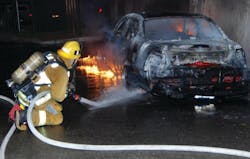The "Green Report" made public on Feb. 12 stated that the likely cause of the explosion was the application of water directly onto combustible metals on the vehicle's steering column.
Crews responded the fire at 546 West Solano Avenue shortly after 9 p.m. on Jan. 9 near the Arroyo Seco Parkway in Elysian Park and found the 2000 Chevy Impala fully involved.
The sedan began leaking fuel, which ignited and was attacked with a dry chemical extinguisher. The captain then observed fire in the passenger compartment and attacked the fire with the initial attack line.
The application of water to the fire around the steering column caused a violent explosion, forcing the captain backwards and causing him to hit his head on the pavement.
During post-incident interviews, he said he recalled the explosion and the next thing he remembered was doctors working on him in the hospital. He did not remember hitting the pavement, being treated at the scene or being transported to the hospital.
The captain was wearing his helmet, turnout coat, turnout pants and turnout boots at the time of the incident, but was not wearing his gloves, hood or SCBA.
He sustained a fractured skull with a cerebral bleed, non-life threatening internal injuries and a small partial thickness burn to his right hand, according to the report.
The LAFD Arson-Counter Terrorism Section and LAPD Bomb Squad found no explosive or incendiary devices in the vehicle. All other causes have been ruled out, leaving the likely cause as water application directly onto combustible metals known to be part of the vehicle's interior construction.
The report cited an article from Automotive Manufacturing and Automotive Materials Partnership that stated the average North American-built family vehicle contains 5 or 6 pounds of magnesium die castings, and the most popular applications include steering column components.
General Motor's -- which manufactures the Impala -- has been expanding use of magnesium parts faster than any of the other domestic automakers due to its abundance, strength and ability to reduce vehicle weight, the article stated.
The LAFD report says that extreme caution should be exercised when approaching a vehicle fire and that firefighters must be aware that it is not uncommon for well-involved interior fires on newer-model vehicles to have combustible metals involved.






